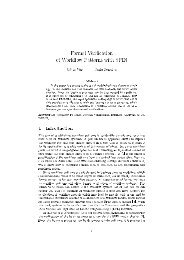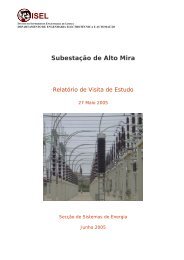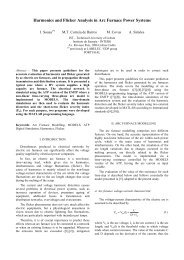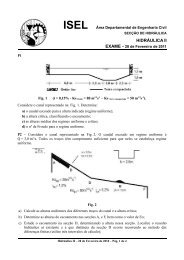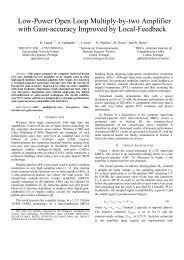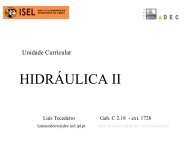Low-Power 6-bit 1-GS/s Two-Channel Pipeline ADC with Open ...
Low-Power 6-bit 1-GS/s Two-Channel Pipeline ADC with Open ...
Low-Power 6-bit 1-GS/s Two-Channel Pipeline ADC with Open ...
Create successful ePaper yourself
Turn your PDF publications into a flip-book with our unique Google optimized e-Paper software.
Using the same auxiliary clock signal, φ aux, and two<br />
NAND gates, the original clock signals, φ 1 and φ 1n, can be<br />
converted into synchronized signals, φ 1s and φ 1ns, according<br />
to the circuit shown in Fig. 6 (b). A second synchronized pair<br />
is also obtained (complementary versions, φ 1sn and φ 1nsn) by<br />
this simple circuit. These signals are then used for locally<br />
and accurately control the gate voltages of the main CMOS<br />
sampling CMOS switch (M 1 , M 2 ), acting through the SLC<br />
auxiliary transistors, M 3 , M 4 , M 5 and M 6 , as displayed in Fig.<br />
6 (a). The switches of the first S/H block, instead of<br />
sampling during phase φ 1, are sampling during φ 1s.<br />
Likewise, the CMOS input sampling switch of the second<br />
S/H block, samples during φ 1ns. When this technique is<br />
applied, there is an efficient cancellation of the time-skew<br />
effect, as shown in Fig. 7 (b) where the same time mismatch<br />
of 150 ps and the same input signal frequency are used.<br />
C. The Flash Quantizer<br />
Each 1.5-<strong>bit</strong> quantizer consists of 2 comparators followed<br />
by a thermometer-to-binary digital encoder and by an X, Y, Z<br />
encoder. Each comparator comprises an input switchedcapacitor<br />
divider network to define the threshold level,<br />
followed by an ordinary dynamic preamplifier/positivefeedback<br />
latch. This comparator was optimized using<br />
exhaustive Monte-Carlo simulations in order to achieve lowoffset,<br />
reduced kickback noise, high mean-time to failure,<br />
and low-power dissipation at the desired speed of operation.<br />
IV. SIMULATION RESULTS<br />
The 1.2 V, 6-<strong>bit</strong>, 1 <strong>GS</strong>/s 2-channel pipeline <strong>ADC</strong> was<br />
fully designed and simulated at transistor level in a 130nm<br />
1P-8M CMOS technology. In order to simplify the layout<br />
effort, all pipelined stages are equally sized, i.e. no scaling is<br />
applied to the 1.5-<strong>bit</strong> MDACs. A scaling-down approach<br />
would optimize further the overall power. Fig. 8 displays the<br />
FFT (1024 bins) of the <strong>ADC</strong> output clocked at 1 GHz when<br />
a full-scale input of 315 MHz is applied.<br />
AMPLITUDE (dB)<br />
0<br />
-10<br />
-20<br />
-30<br />
-40<br />
-50<br />
-60<br />
-70<br />
-80<br />
-90<br />
HD3<br />
-100<br />
0 0.5 1 1.5 2 2.5 3 3.5 4 4.5 5<br />
ANALOG INPUT FREQUENCY (Hz)<br />
x 10 8<br />
Figure 8. Simulated FFT Spectrum <strong>with</strong> 1024 <strong>bit</strong>s for f clk=1 GHz and<br />
f in=315 MHz (coherent sampling).<br />
A peak SNR of 34.6 dB is obtained through analytical<br />
calculations when 4 pF and 0.3 pF unit capacitors are used<br />
respectively in the S/Hs and 1.5-<strong>bit</strong> MDACs. Simulations<br />
HD5<br />
HD11<br />
show a THD of –43 dB, a SFDR of 47 dB, and a peak SNDR<br />
larger than 34 dB corresponding to an ENOB better than<br />
5.35 <strong>bit</strong>s. The Gain error/time-skew spur is 50 dB below the<br />
signal. Due to the single-phase scheme used, the highest<br />
harmonics are HD5 and HD11 rather than HD3.<br />
The circuit dissipates less than 20 mW (11 mW analog<br />
and 9 mW digital) <strong>with</strong> 1.2 V and at 1 <strong>GS</strong>/s, corresponding<br />
to an energy efficiency better than 0.5 pJ. When comparing<br />
the energy efficiency <strong>with</strong> the state-of-the-art of lowresolution<br />
pipeline <strong>ADC</strong>s employing open-loop residue<br />
amplification [4] (ENOB=5.3 <strong>bit</strong>s, Fs=800 MS/s, <strong>Power</strong>=105<br />
mW), this work exhi<strong>bit</strong>s an improvement (based on<br />
simulation results) of a factor higher than 6.6. Furthermore,<br />
no calibration scheme is required.<br />
V. CONCLUSIONS<br />
A low-power 1.2 V 6-<strong>bit</strong> 1-<strong>GS</strong>/s time-interleaved<br />
pipeline <strong>ADC</strong> designed in 130 nm CMOS was described. It<br />
is based on a new 2-channel 1.5-<strong>bit</strong> MDAC that performs<br />
open-loop residue amplification using a shared amplifier<br />
employing local-feedback. Time mismatches between<br />
channels are highly attenuated, simply by using two passive<br />
front-end S/H circuits, <strong>with</strong> dedicated SLC circuits, driven<br />
by a single clock phase. Simulated results of the <strong>ADC</strong><br />
achieve 5.35-<strong>bit</strong> ENOB, <strong>with</strong> less than 20 mW and <strong>with</strong>out<br />
requiring any gain control/calibration scheme.<br />
ACKNOWLEDGEMENTS<br />
This work was partially supported by the Portuguese Foundation for<br />
Science and Technology (FCT/MCTES) under LEADER (PTDC/EEA-<br />
ELC/69791/2006), SIPHASE (POSC/EEA-ESSE/61863/2004) and SPEED<br />
(PTDC/EEA-ELC/66857/2006) projects.<br />
REFERENCES<br />
[1] C. S. G. Conroy, D. W. Cline, and P. R. Gray, “An 8-b 85-MS/s parallel<br />
pipeline A/D converter in 1-µm CMOS,” IEEE J. Solid-State Circuits, vol.<br />
28, pp. 447–454, Apr. 1993.<br />
[2] S. Gupta, et. al., “A 1<strong>GS</strong>/s 11b Time-Interleaved <strong>ADC</strong> in 0.13um<br />
CMOS”, Proc. IEEE ISSCC Dig. Tech. Papers, pp. 576–577, Feb. 2006.<br />
[3] B. Murmann and B. E. Boser, “A 12-<strong>bit</strong> 75 Ms/s pipelined <strong>ADC</strong> using<br />
open-loop residue amplifier,” IEEE J. Solid-State Circuits, vol. 38, no. 12,<br />
pp. 2040–2050, Dec. 2003.<br />
[4] Ding-L. Shen, Tai-C. Lee, “A 6-<strong>bit</strong> 800-MS/s <strong>Pipeline</strong>d A/D Converter<br />
With <strong>Open</strong>_Loop Amplifiers”, IEEE J. Solid-State Circuits, vol. 42, no. 2,<br />
pp. 258-268, Feb. 2007.<br />
[5] A. Galhardo, et al., “Novel Linearization Technique for <strong>Low</strong>-Distortion<br />
High-Swing CMOS Switches <strong>with</strong> Improved Reliability”, Proc. IEEE<br />
ISCAS’06, pp. 2001-2004, May 2006.<br />
[6] A. Galhardo, et al., “Design of <strong>Low</strong>-Voltage <strong>Low</strong>-<strong>Power</strong> <strong>Pipeline</strong><br />
<strong>ADC</strong>s Using a Single-Phase Scheme”, IEE Proc. ADDA’2005, pp. 195-<br />
200, July 2005.<br />
[7] K. Philips, E. Dijkmans, “A Variable Gain IF Amplifier <strong>with</strong> -67dBc<br />
IM 3-Distortion at 1.4V pp Output in 0.25 µm CMOS”, Symposium on VLSI<br />
Circuits Digest of Technical Papers, pp. 81-82, June 2001.<br />
[8] M. Waltari, K. Halonen, “Timing Skew Insensitive Switching for<br />
Double-Sampled Circuits”, Proc. IEEE ISCAS’99, vol.2, pp. 61-64, June<br />
1999.<br />
[9] G. Léger, et al., “Impact of Random <strong>Channel</strong> Mismatch on the SNR and<br />
SFDR of Time-Interleaved <strong>ADC</strong>s”, IEEE Trans, Circuits ans Systems – I,<br />
vol. 51, no. 1, pp. 140-150, Jan. 2004.





